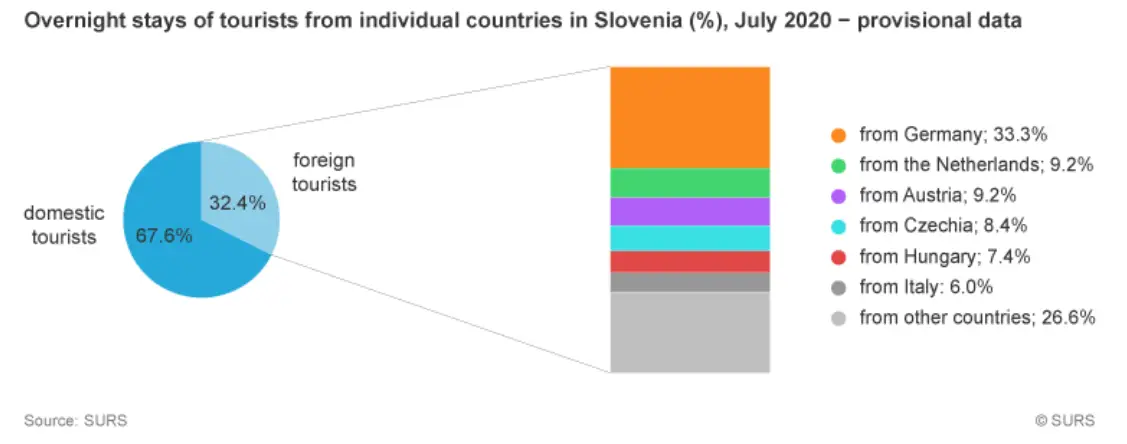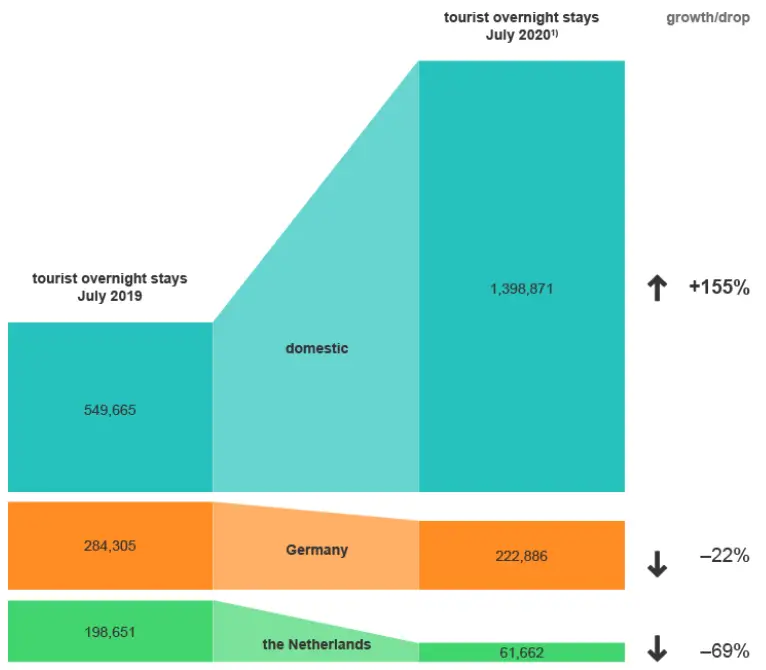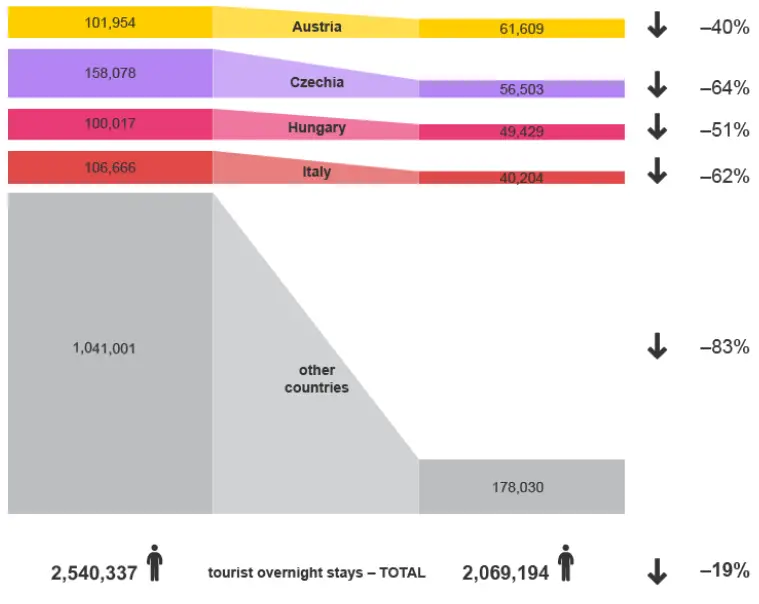STA, 25 August 2020 - The Slovenian tourism industry, which has been severely affected by the Covid-19 epidemic, saw an upbeat trend in Slovenian tourist arrivals and nights in July, partly offsetting the low numbers from the first half of the year, show the latest figures released by the Statistics Office on Tuesday.
Over 653,000 arrivals were recorded at accommodation facilities in July, down 27.5% compared to July 2019, with the number of nights down by 18.5% to 2.07 million.
However, the number of Slovenian tourists in the overall number increased by 176% to almost 404,000, and the number of nights they spent there by 155% to nearly 1.4 million.
The number of foreign arrivals meanwhile dropped by 67% to slightly over 249,300, and the number of nights they spent in Slovenia by 66% to over 670,300.
Germans spent the most nights in Slovenia in July, or 33%, followed by the Dutch and Austrians (9% each), Czechs (8%) and Hungarians (7%).
The most popular areas for tourists, domestic and foreign, were mountainous areas, which accounted for 35% of all tourist nights, followed by the coast (29%).
Thirty percent of all nights were made at hotels, 27% at private rooms, self-catering units and houses, and 22% at camping sites.
Although several areas in Slovenia have had a good summer season, Slovenian tourism has been considerably affected by the epidemic, with facilities in full lockdown for several weeks.
The January-to-July period saw almost 1.6 million tourist arrivals, a 54% drop compared to the same seven-month period in 2019. Tourist nights meanwhile dropped by 48% to around 4.6 million.
In the first half of the year, arrivals by Slovenian tourists dropped by 5% but a 2% rise was recorded in nights generated by domestic guests compared to January-July last year. The number of foreign tourists arriving in Slovenia plummeted by 71% and the nights they generated by 68%.
The figures are in line with the Slovenian Tourist Board's projections of a 70% drop in foreign arrivals for the year and of a 50% overall drop because of a rise in domestic tourists.
To help the industry survive, the government introduced a special voucher scheme, giving every permanent resident EUR 200 to spend in Slovenia until the end of the year on bed and breakfast, with minors receiving EUR 50.
Presenting the latest figures about the vouchers, Economy Minister Zdravko Počivalšek said Sunday was a new milestone as over 500,000 vouchers had been redeemed.
"In a good two months since this measure was introduced, a quarter of all vouchers have already been spent, while bookings for another 30,000 have already been made."
Figures from the Financial Administration show that 511,554 vouchers, worth EUR 69.8 million, were redeemed between 19 June and 23 August, whereas the total value of vouchers available is around EUR 357 million.
Počivalšek believes the tourist vouchers have saved the summer season for many tourism companies or helped some survive the epidemic, at the same time enabling many to be able to afford to go on a holiday.
He is also confident that thanks to the vouchers, Slovenians have discovered many corners that have so far been less known and less visited. He hopes the thrill at discovering Slovenia turns into a trend of Slovenians spending at least part of their holidays at home.
Although it is too early to take stock of the summer season, Počivalšek said "we are better off than some comparable countries".
In July and August, tourist numbers at some locations were already on a par with or even better than last year, the only difference being that domestic tourists outnumbered foreign ones, he explained.
He believes these figures could hardly be reached if the epidemiological situation had not been kept under control. He thus urged tourism companies to be innovative in providing for coronavirus safety, so that foreign tourists could soon return in bigger numbers.
As for extending the use of vouchers into the spring of 2021, the minister said efforts were now focussed on encouraging people to use them by the end of the year.
"Should any other measures be needed, I believe we'll take them in time," Počivalšek said at a news conference in Ljubljana.
Over EUR 1 million in vouchers was spent a day in the period between 19 June and 23 August, with the average age of tourists using the vouchers at slightly over 38.
The figures also show over 55,700 people aged an average 64 years transferred their vouchers on family members, meaning many elderly did not go on holiday themselves.
You can see more of this data at SURS









